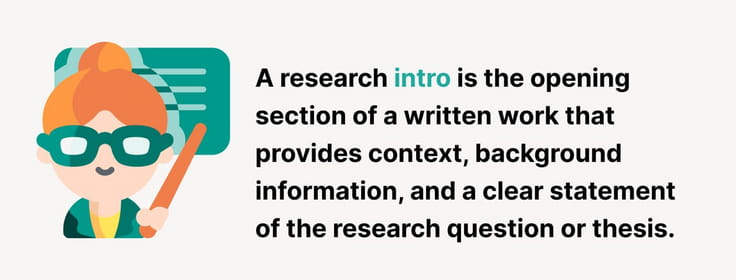Research Introduction Generator
📖 Introductions in Research
Research is crucial in developing new knowledge, solving complex tasks, and gaining headway in various fields. Sometimes, a researcher has the perfect subject to work with and is ready to write about it. However, they realize that they struggle to compose their thoughts and start on their task.

Our research introduction generator is perfect for such occasions.
The tool:
- Is easy to use,
- Saves time,
- Helps tailor a unique introduction.
The tool might inspire you to take the paper in a new direction. Aside from a user-friendly instrument, we also provide valuable information and advice to make paper writing much easier.
Essay Writing and Introductions
The introduction is the first part of a research paper or an essay in an academic setting. It explains the reason for looking into an issue, its significance, and its goals. With that said, an introduction doesn't cover the study methods or the results of the study. There are separate paper sections to expand on this information in great detail.
A good intro begins with a general statement and narrows it down to the selected research subject. It provides used sources and is usually no longer than four paragraphs. However, the size of the introduction may vary depending on the style guide and research topic. It differs from one field to another, which our introduction in research generator is designed to accommodate.
How to Structure an Intro Paragraph
The introduction gives a concise overview of your research. Important background information makes it easier for the audience to comprehend the significance of your work. Understanding the proper structure of the introduction is vital to get your point across in a straightforward manner.

✅ 7 Tips for Successful Research Paper Introductions
This section covers the most effective tips for improving your introduction. Several things play into its success:
- Start with the general and narrow it down. The first paragraph briefly covers the broader research field and moves to a particular subject. This approach makes the paper easier to understand for the wider audience.
- Explain the importance and objectives. One should clearly state their aims with a particular research topic. Otherwise, the readers won't understand why they should care about its outcome.
- Use the right amount of citations. The introduction should be based on the latest related data. Do not overuse quotations, as they distract readers from the paper itself.
- Provide a clear-cut research question or hypothesis. The former works best for papers on formal sciences and exploratory research. You may use the later format for empirical scientific research.
- Provide an overview of the paper when possible. The last part of the introduction may include a rundown of the document's structure. Note that its addition varies from one discipline to another. It's more prevalent in papers on technology and less so in medical research.
- Keep it short. The introduction part should be around 500-1000 words. Check the guidelines or ask your professors to better pinpoint the right length for your intro.
- Don't provide too much detail. Avoid mentioning too many specifics in the introductory part. There will be dedicated sections of the paper disclosing them later on. Better use general statements and exclude lengthy explanations.
⚡ 7 Mistakes to Avoid When Writing an Intro
Introductions are often considered to be the most difficult part of writing an essay – perhaps, even more difficult than conclusions! This is why we've also prepared a list of common mistakes you better avoid when working on them.

Our research introduction generator will help deal with your writer's block and be beneficial in later work! Remember to give our FAQ a look.
❓ Research Introduction Generator - FAQ
Updated:
🔗 References
- Introduction to Research. – Richard F. Taflinger, Washington State University
- Introduction Sections in Scientific Research Reports. – George Mason University
- How to Write a Good Introduction in 3 Steps (With Example). – Indeed
- The Role of an Introduction. – Pomona College
- 5 Things to Avoid When Writing an Introduction. – Walden University
- Introduction to Research. – Michigan Technological University
- Introductions and Conclusions. – Leora Freedman and Jerry Plotnick, University of Toronto
- Avoid these three mistakes when writing your introduction. – David Otey, Speaking of Solutions
- Organizing Academic Research Papers: The Introduction. – Sacred Heart University Library
- Introductions. – University of North Carolina at Chapel Hill